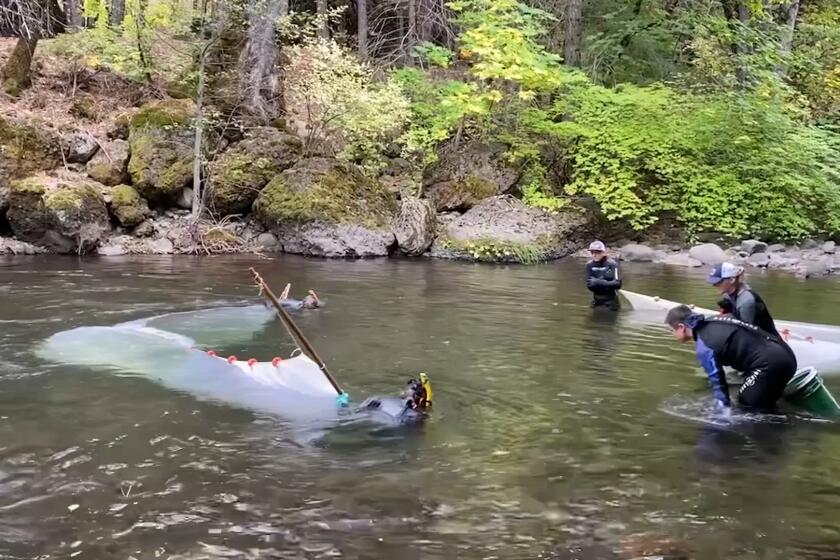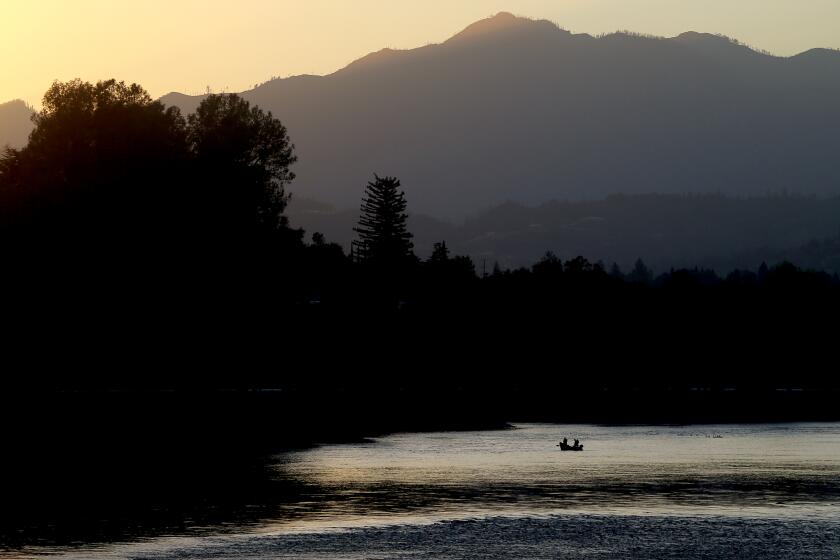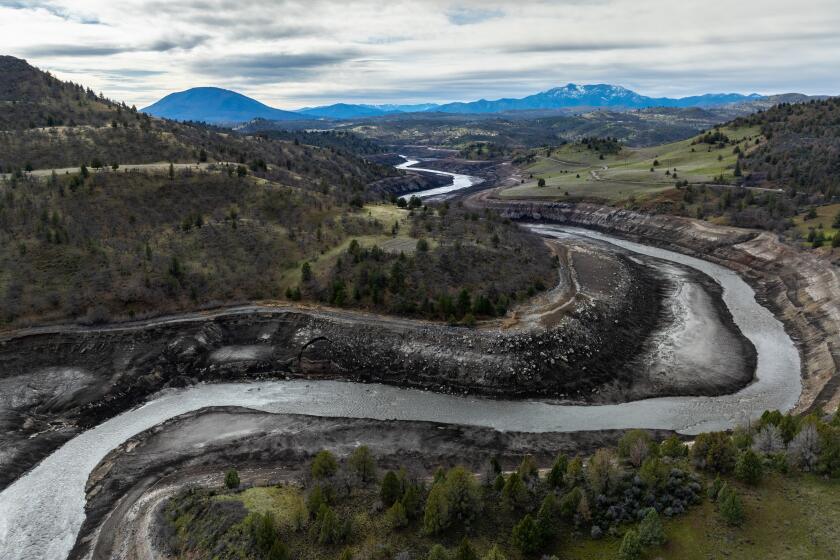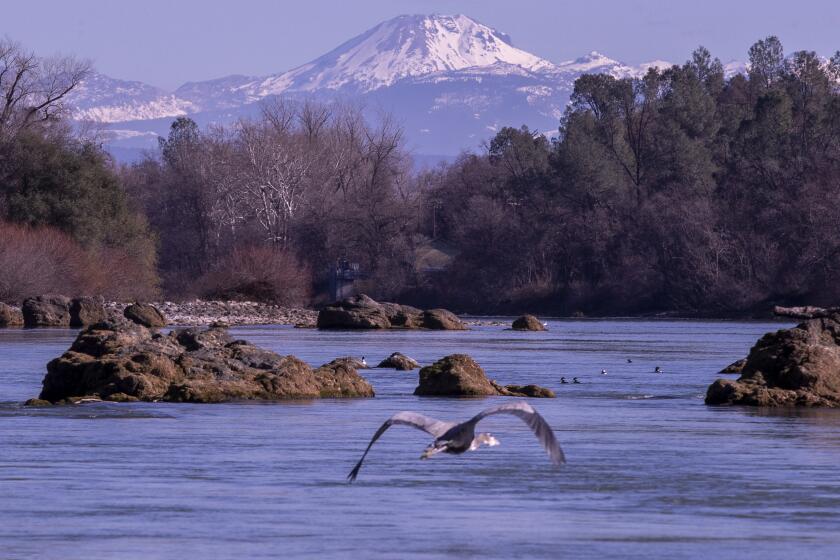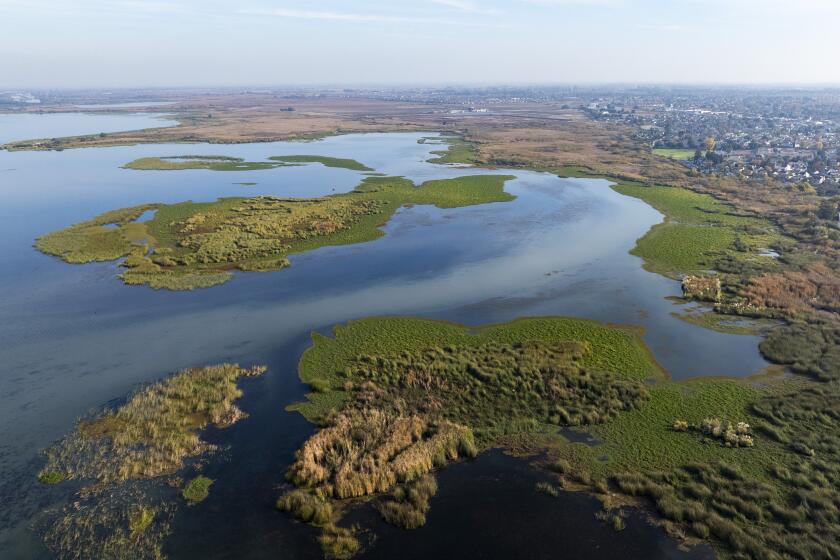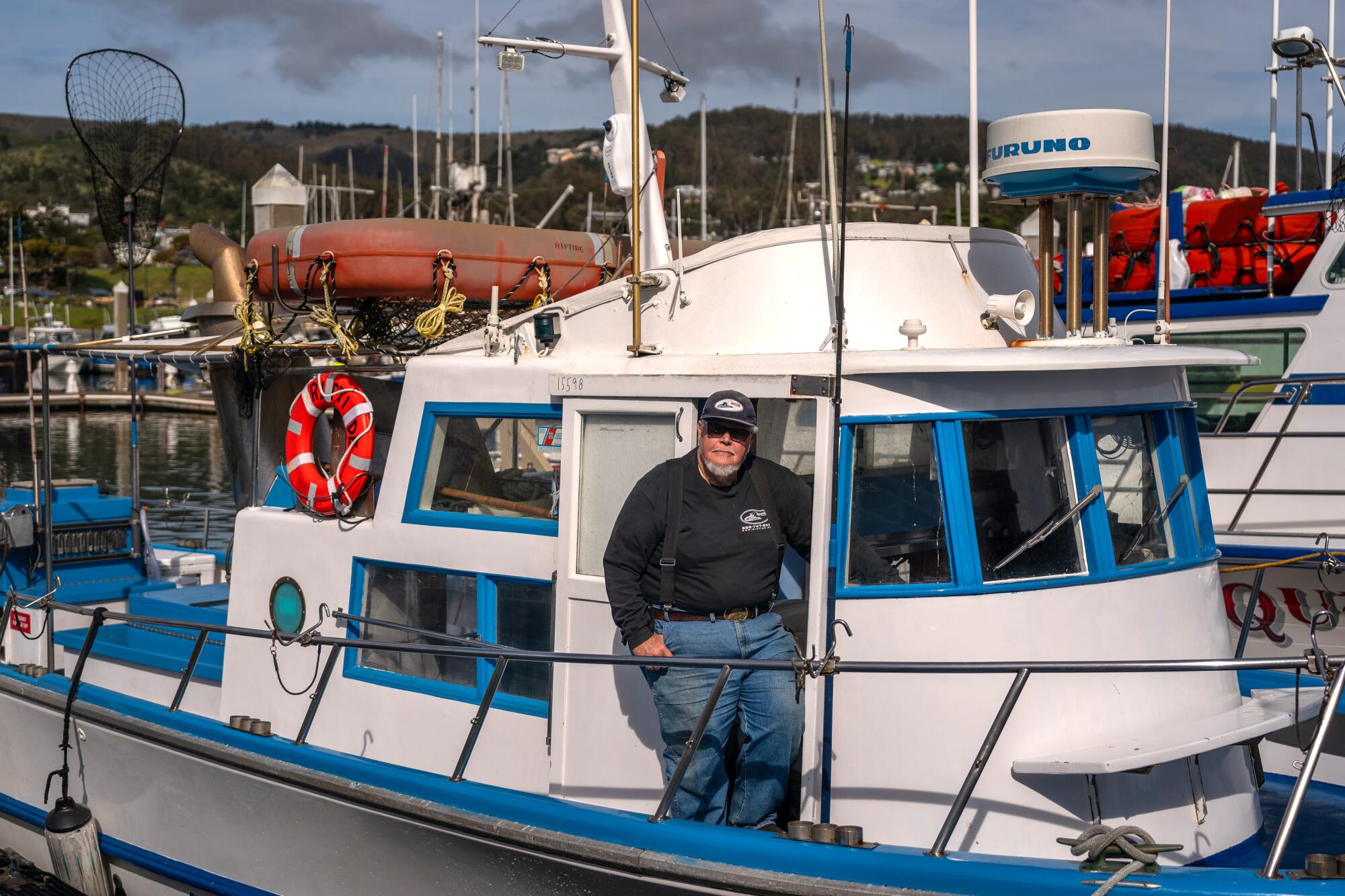
- Share via
HALF MOON BAY, Calif. — On the docks at Pillar Point Harbor, fishing crews have been arriving with loads of freshly caught Dungeness crab.
The season is almost over, and this time of year the harbor would typically be bustling with crews preparing their vessels and gear for catching salmon. But this year, those in the fishing fleet of Half Moon Bay — as well as other California marinas — expect to catch very few, if any, of the popular fish.

The season typically runs from May to October, but California Chinook salmon populations have declined so severely in recent years that fishery authorities are considering whether to adopt severe restrictions this season or impose a ban on fishing altogether for the second consecutive year.
For those whose livelihoods revolve around catching salmon, the shutdown has brought hard times and widespread frustration.
“It’s devastating. It’s absolutely devastating,” said commercial fisherman Chris Pedersen. “They’re literally killing the salmon fleet.”
Aggressive and impactful reporting on climate change, the environment, health and science.
Pedersen, who is 64 and has been fishing for salmon since he was a boy, turned to other work over the past year to make ends meet. He has fiberglassed boats, delivered meals and built sheds at a horse ranch.
“You’ve got to do whatever you can to live,” he said.
As he prepared to unload the day’s catch from a 50-foot boat, Pedersen said that selling crab has brought him income but can’t make up for the loss of salmon.
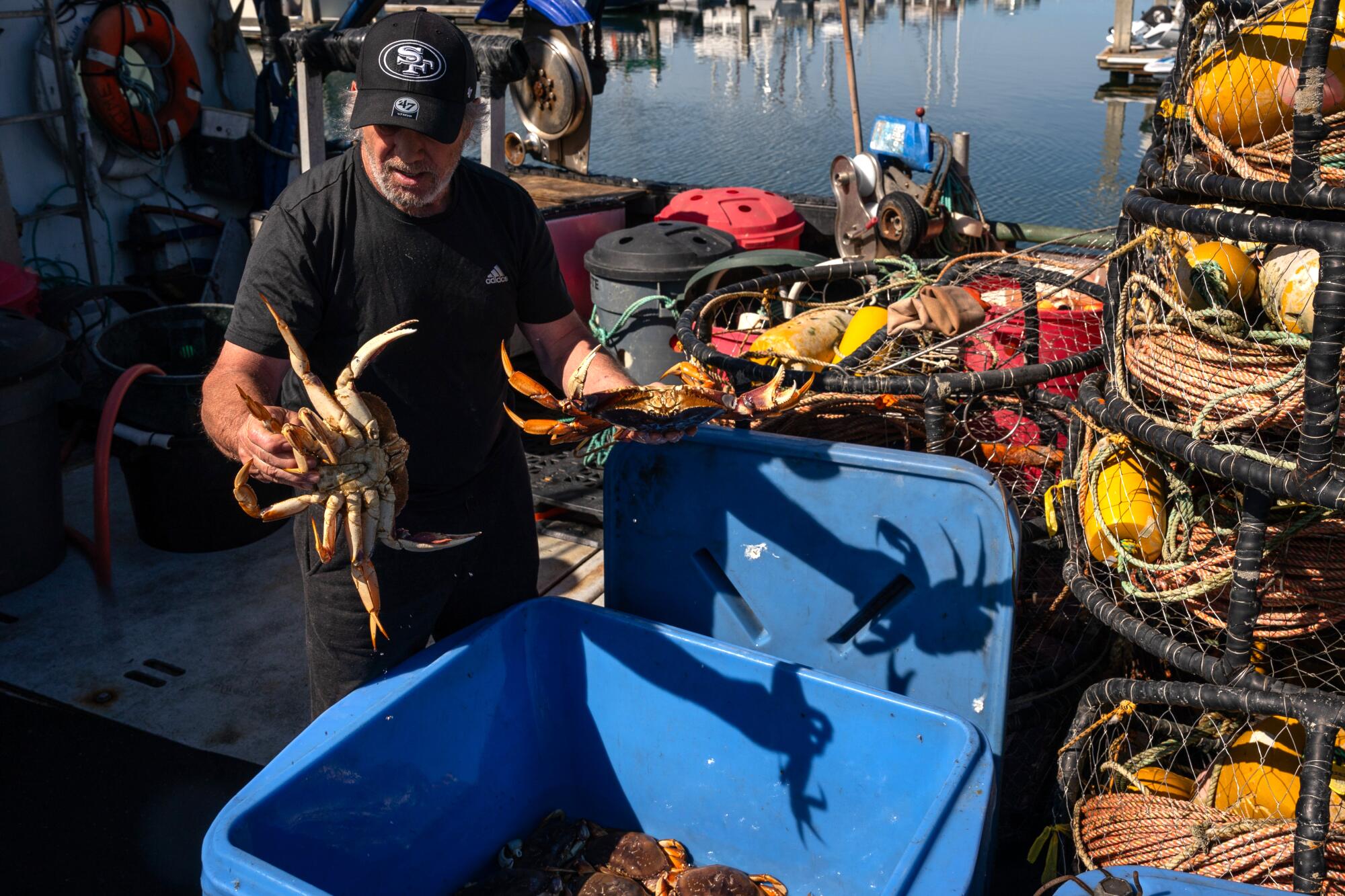
Like other salmon fishers at Pillar Point, Pedersen lays much of the blame on California water managers, who he says send too much water to farms and cities and deprive rivers of the cold flows salmon need to survive. When salmon suffer, he said, “you’re robbing us as fishermen.”
Salmon once thrived in California’s rivers, but the construction of dams blocked them from reaching many of the cold mountain streams where they once spawned. For decades, government-run hatcheries have reared and released millions of salmon each year. Those efforts, however, haven’t been enough to prevent populations from crashing.
Successive droughts and the effects of global warming also have added to the severe pressures. At times during the 2020-22 drought, the water flowing from dams got so warm that it was lethal for salmon eggs. And because salmon typically feed in the ocean for about three years and then return to their natal streams, the decline in the numbers of surviving juvenile fish during the drought has left low numbers of adult fish.
Biologists have begun collecting California’s spring-run Chinook salmon to raise them in captivity in an effort to prevent extinction.
Seeking to help struggling salmon populations, Gov. Gavin Newsom’s administration in January announced plans to expand efforts including restoring habitats, protecting flows in rivers at key times, modernizing hatcheries and removing barriers that block fish migration.
The shutdown of the salmon season last year has taken a major toll not only on the commercial fishing fleet but also on operators of charter fishing boats.
William Smith, who goes by Captain Smitty, said he lost about three-fourths of his charter business because he couldn’t take passengers salmon fishing, and also saw losses because of restrictions on the rockfish season.
1

2
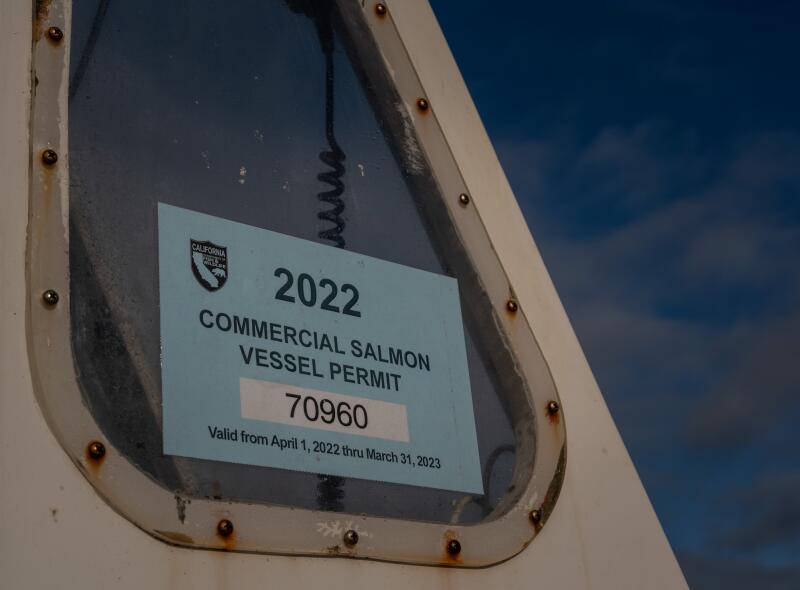
3
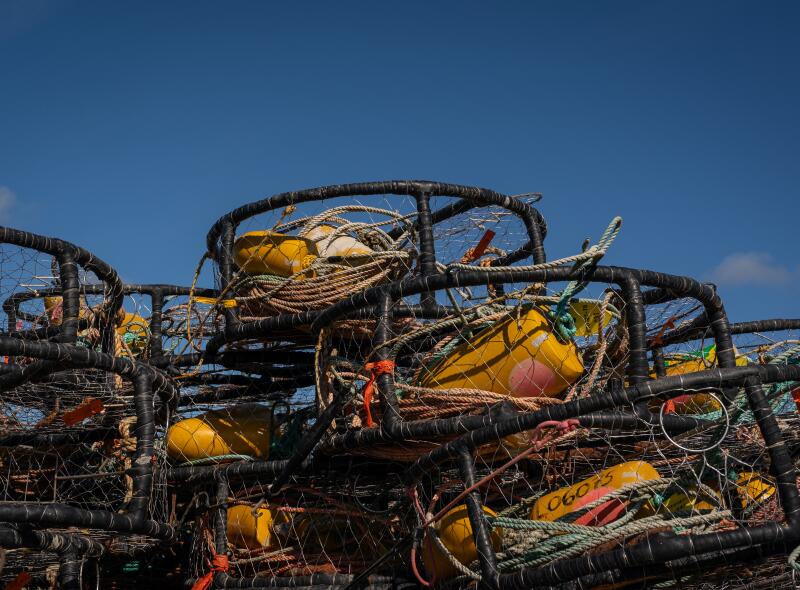
1. Captain William “Smitty” Smith wears a boat wheel necklace. 2. A boat in Half Moon Bay has a commercial salmon fishing permit from the last season. 3. Crab pots are piled on the deck of a commercial fishing boat in Half Moon Bay. (Loren Elliott/Los Angeles Times)
Smith has turned to the business of burials at sea, taking grieving families to scatter the ashes of loved ones. He has also been promoting whale watching trips.
“Financially, this really has just been a disaster,” said Smith, 70. “All of us are struggling to make our minimum payments.”
Smith owns a vessel named Riptide, the same boat where he started working as a deckhand in the 1970s. He said he hopes his grandson can one day take over the business and continue fishing for salmon.
Although state estimates show a modest increase in numbers of fall-run Chinook this year compared with last year, fisheries officials say restrictions are necessary because the population is still struggling.
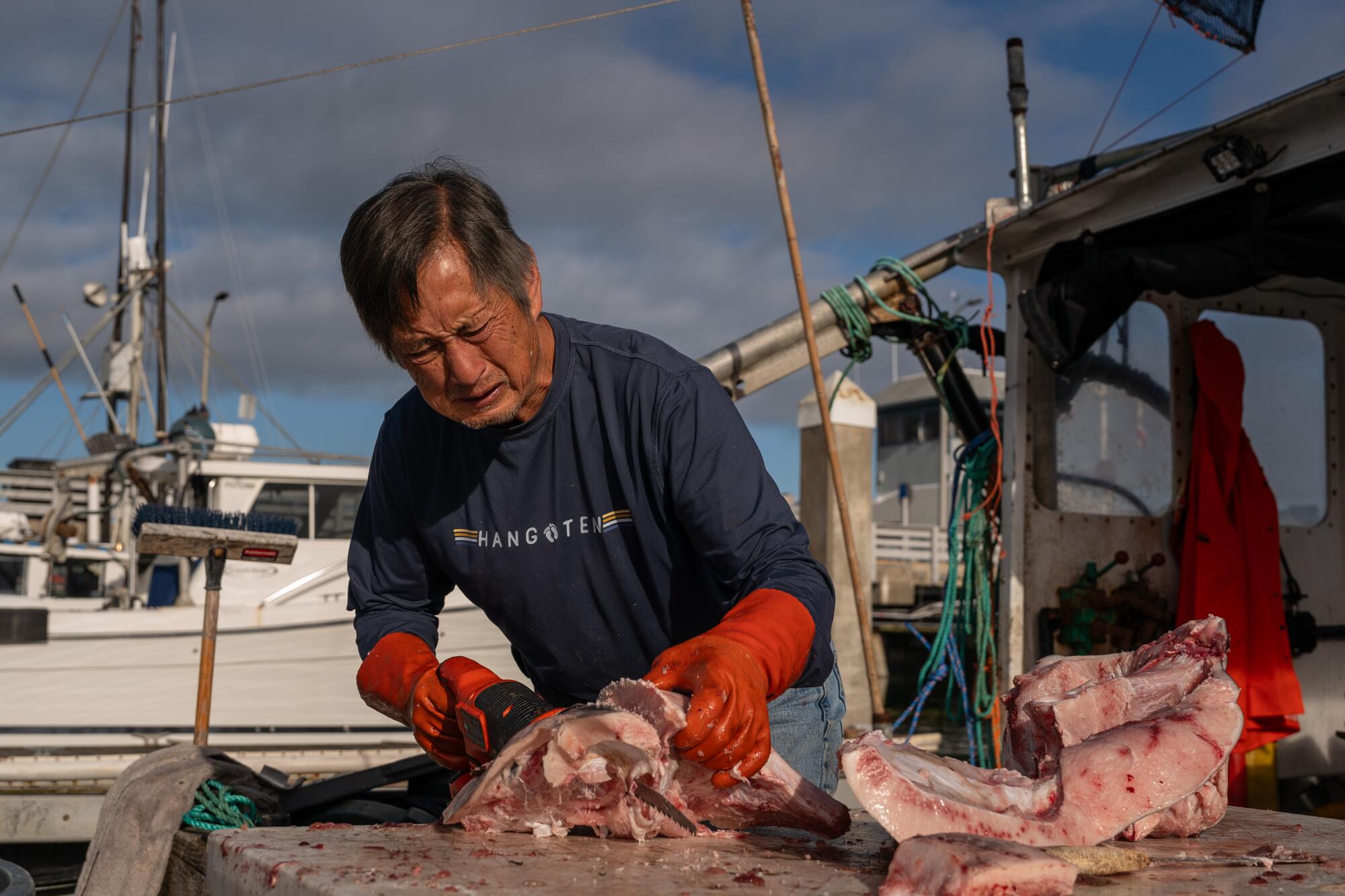
The Pacific Fishery Management Council, a multistate, quasi-federal body that decides on ocean fishing seasons, plans to select one of three potential alternatives at a Friday through April 11 meeting in Seattle. One option would be to ban coastal salmon fishing for another year, while the other two options would bring a limited season restricted to certain dates and harvest limits.
Those with commercial and recreational fishing businesses have varying opinions about which approach would be best. Smith said he and many other charter boat captains would prefer to see the season canceled, rather than shortened, in hopes of helping the population recover and having a full season next year.
“We all want to see the fishery return to a sustainable level,” Smith said.
Environmentalists are calling for federal intervention after 4,000 threatened fish were killed by pumps operated by the State Water Project and the Central Valley Project.
He said he believes a rebound is possible but that it will require changes in how state and federal officials manage flows in rivers.
“The vast majority of the problem is due to water mismanagement,” Smith said. “If the water was managed more correctly, then we would not be facing this crisis.”
Smith and other fishermen say they’re concerned that the way officials managed water releases from dams during the drought failed to provide the cold water salmon needed. They also argue the state has been allowing excessively large amounts of water to be pumped from the Sacramento-San Joaquin River Delta to supply agriculture, irrigating vast acreages of almonds, rice, tomatoes and other crops.
“We just need to rein in the abuse of water and grow crops that are not so water intensive,” said Duane Winter, a charter boat captain who has lost most of his business because of the shutdown.
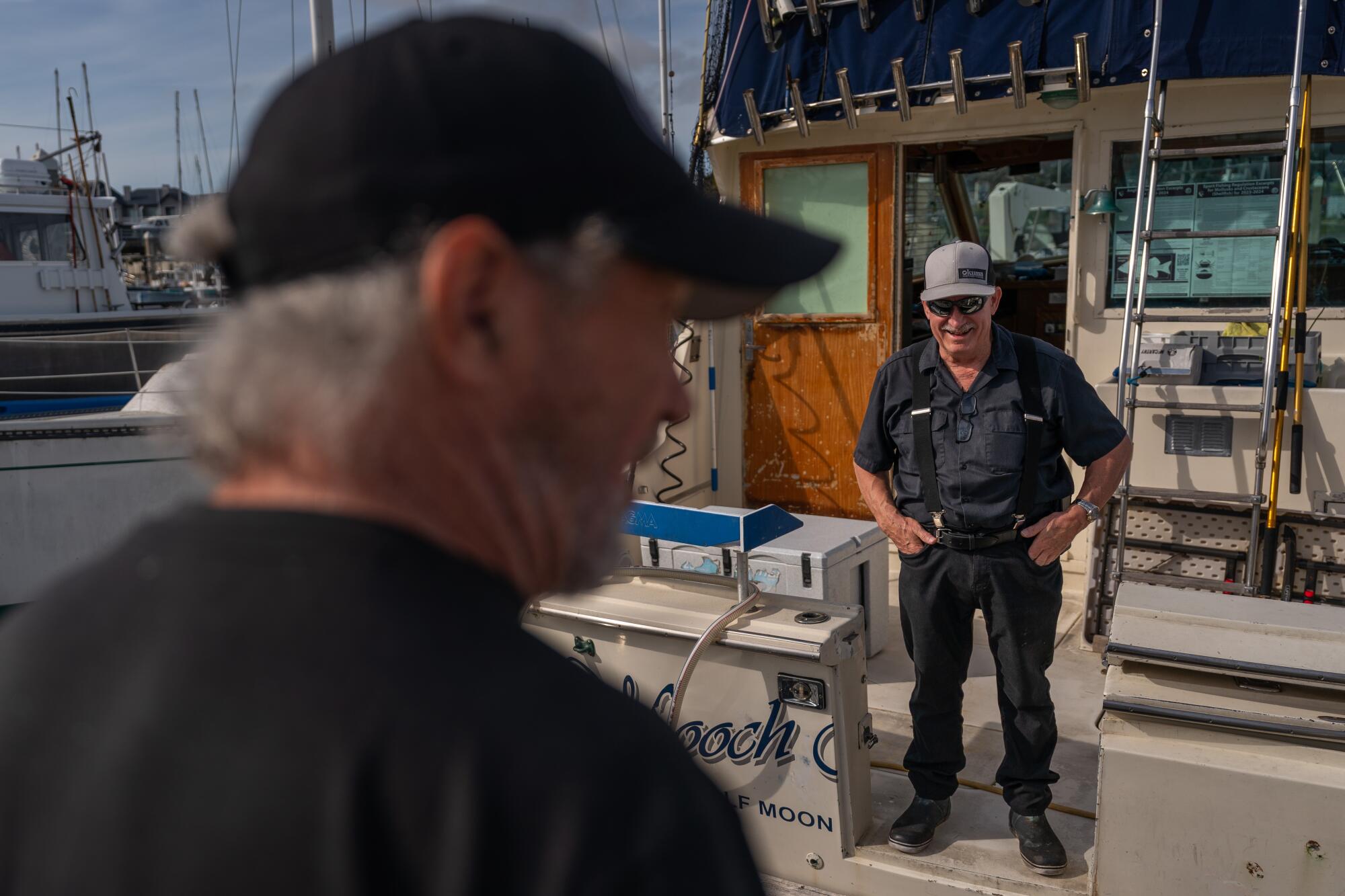
“The problem is, fish don’t pay for water, and everybody else does. And so fish don’t get a fair shake,” Winter said.
With his 37-foot boat tied up at the dock for most of last year, Winter turned to part-time work at a machine shop to help cover his expenses. Without that side job, Winter said, he would have had to put up his boat for sale by now.
Others in Half Moon Bay have their boats on the market, and prices have fallen.
Winter said the lack of fishing income combined with the state’s tightening air-quality standards for engine exhaust could drive him out of business.
“I may not be fishing next year,” Winter said. “It’s hard to be optimistic with the way things are going.”
Winter stood on the deck of his boat, named Mooch Better, where he had laid out tools to replace engine parts.
He noted that many factors have harmed the Chinook, such as non-native striped bass that feed on young salmon passing through the delta, and algae blooms that at times starve the water of oxygen.
If the state doesn’t make changes to ensure more water for fish, Winter said, “it’s going to continue down this road to destruction.”
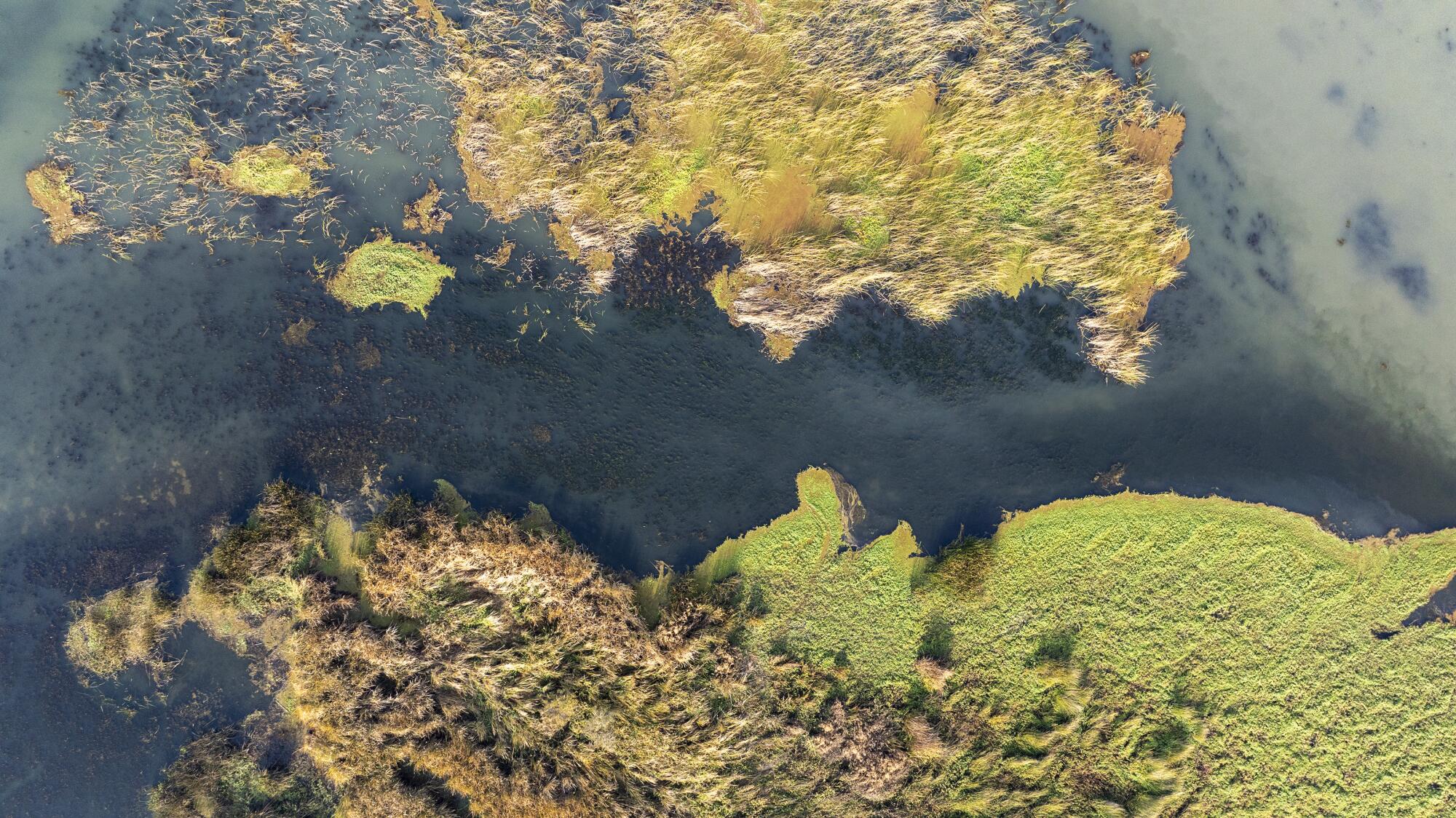
California’s fishing industry depends on fall-run Chinook, which migrate upstream as adults from July through December. Some fish return to the hatcheries where they were released, while others spawn along tributaries of the Sacramento, San Joaquin and Klamath rivers.
Salmon are also central to the cultures of Native tribes, whose leaders canceled subsistence fishing last year.
Other salmon runs have declined to a point that they are at risk of extinction. Spring-run Chinook are listed as threatened under the Endangered Species Act; winter-run Chinook are endangered.
State fisheries officials say while it’s a difficult period for fall-run Chinook, there are some encouraging signs, including an uptick in the projected numbers of fish along the coast.
“There is a glimmer of good news,” said Chuck Bonham, director of the California Department of Fish and Wildlife. “The numbers we’re seeing right now look a little bit better than last year. And that is great. But they’re still low enough, we need to be really cautious and think about the long term.”
The limited options that are being considered for the upcoming salmon season, he said, are intended to give the fish a chance to rebound through this “sensitive period.”
In an interview with The Times, Bonham said a combination of factors have contributed to the low salmon numbers, including the latest severe drought, the lack of natural floodplains available to fish, the lack of access to cold, clean waters, and some of the state’s water management decisions.
“Water management is absolutely one of the central issues,” Bonham said. “Those fish need cold, clean water in the right places at the right time of the year to thrive.”
He said that’s why the Newsom administration’s salmon strategy includes detailed plans for protecting flows and water quality in key rivers to support fish.
Reservoirs have been drained as the nation’s largest dam removal effort advances on the Klamath River, and an effort to restore the watershed is taking root.
In all, the state’s plan calls for prioritizing 71 actions to help restore salmon populations to healthier levels. The efforts include restoring wetlands to create more habitat along the Sacramento River, and cooperating with the Winnemem Wintu Tribe to reintroduce salmon upstream of Shasta Dam.
State and federal scientists have also been trying to address a deficiency of thiamine that is harming salmon. The deficiency has been linked to changes in the ocean ecosystem, where salmon have been feeding on more anchovies. In response, officials have been treating water in hatcheries and injecting thiamine into salmon eggs to help fish survive.
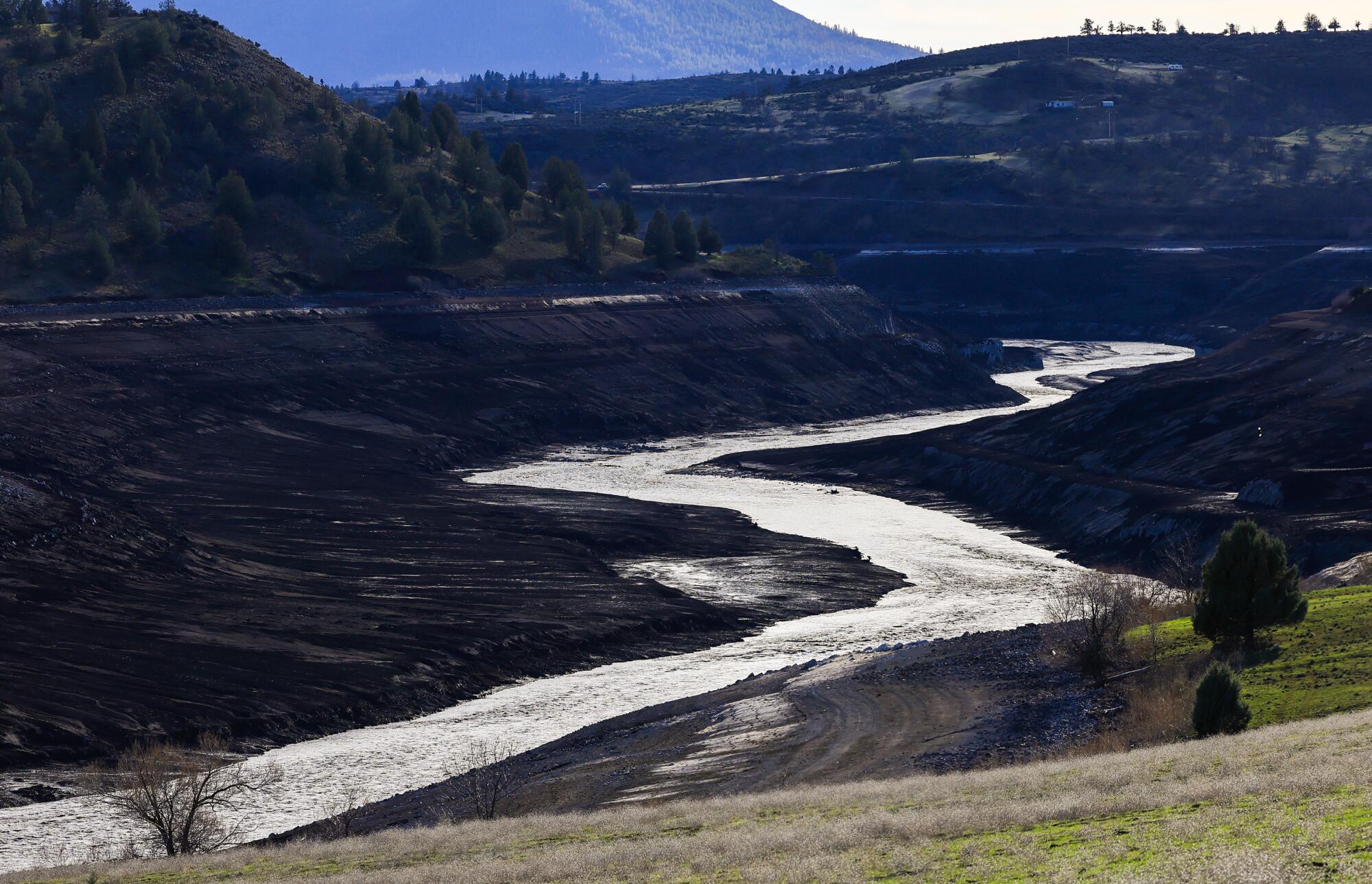
On the Klamath River, the largest dam removal project in history is underway, and state officials tout the effort as one of various steps to remove barriers and “modernize infrastructure” for salmon migration.
Bonham said state officials are working with “a lot of urgency” on a three-year timeline.
“We’re going to have to do all the above,” he said. “We have got to pull out all the stops.”
The Winnemem Wintu Tribe has signed agreements with California and the U.S. government to work together on efforts to restore salmon upstream from Shasta Dam.
He noted that California has lost about 90% of the wetlands that once existed, leaving fish with a “highly engineered world” of rivers disconnected from floodplains that traditionally provided rich habitats. On top of that, climate change is bringing more extreme heat and more intense swings from wet periods to droughts.
The existing statistical models that have been used to make decisions about salmon rely on past data and “aren’t prepared to deal with climate disruption,” Bonham said, which demands new approaches. The Department of Fish and Wildlife has also started reviewing how to improve hatchery operations.
With these steps, Bonham said, the state “has a chance to change the trajectory.”
And that could be helped by the last two wet winters, he said, which filled rivers with abundant flows and brought better conditions for fish. In the past, wet years have brought increases in salmon populations three years later.
He said there are other signs that are cause for optimism, including increased numbers of salmon coming back to the San Joaquin River and other creeks.
“Hope is very much alive for salmon in California,” Bonham said. “We think they can not only hang on in the state but thrive, and get back to healthy numbers each year, where people can enjoy them.”
The Delta Conveyance Project is a key component of Gov. Gavin Newsom’s strategy for a hotter, drier California. Opponents say it will be an ecological disaster.
The Golden State Salmon Assn., which represents fishing communities, praised many of the initiatives in the state’s plan, but said it doesn’t do nearly enough to ensure sufficient water in rivers for fish.
“We’re missing the big picture, and the big picture is the flows and the temperature to save fish,” said Scott Artis, the association’s executive director. “California’s water policies really are just one devastating blow after the other for thousands of families that rely on salmon.”
Last year’s shutdown has affected not only commercial and recreational fishers but also related businesses, including shops that sell bait and tackle. Whether this year brings another closure or a restricted season, Artis said, it’s going to mean more economic impacts for people who depend on fishing.
Although the federal government has announced $20.6 million in disaster relief funds for California fishing communities affected by the shutdown, the assistance turned out to be much less than the $45 million the state requested. And the funds have yet to be distributed.
If fishing is allowed this year, Pedersen said he will haul in as many salmon as is permitted. But he worries that a limited window of dates could lead to fishing in windy, rough weather, making for dangerous conditions.
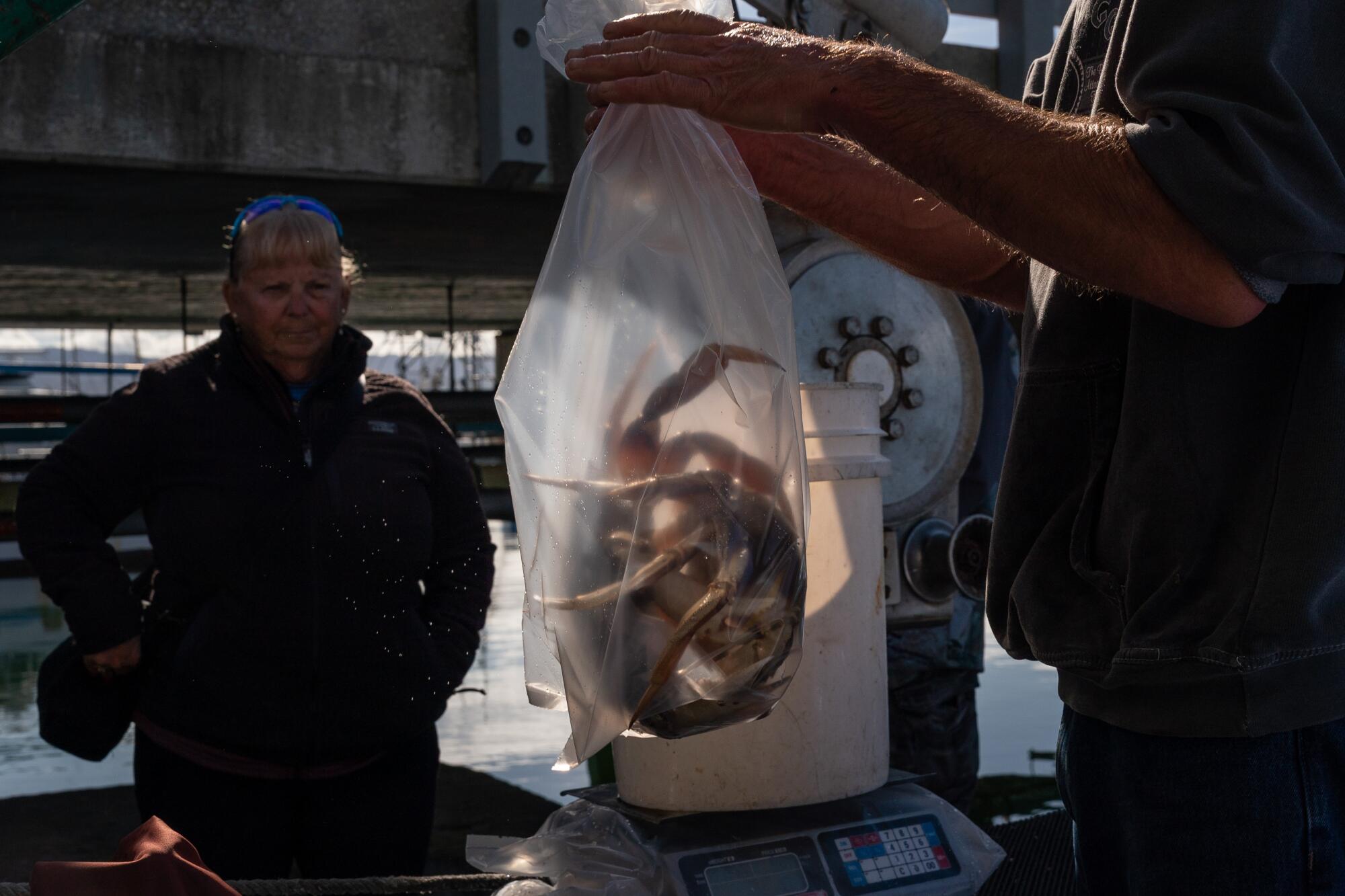
Whatever happens, he is making plans to supplement his income by traveling to Oregon and Washington this summer to fish for albacore tuna.
Pedersen said he still loves fishing and wouldn’t trade it for any other line of work. But as he chatted with another fisherman, he said those who sold their boats a couple of years ago got out just in time.
“The rest of us are still hanging on by a thread that’s breaking severely,” he said.
“I think the future is bleak. I’m hoping I get to fish until I die,” he said. “That’s my whole goal, my whole life.”

